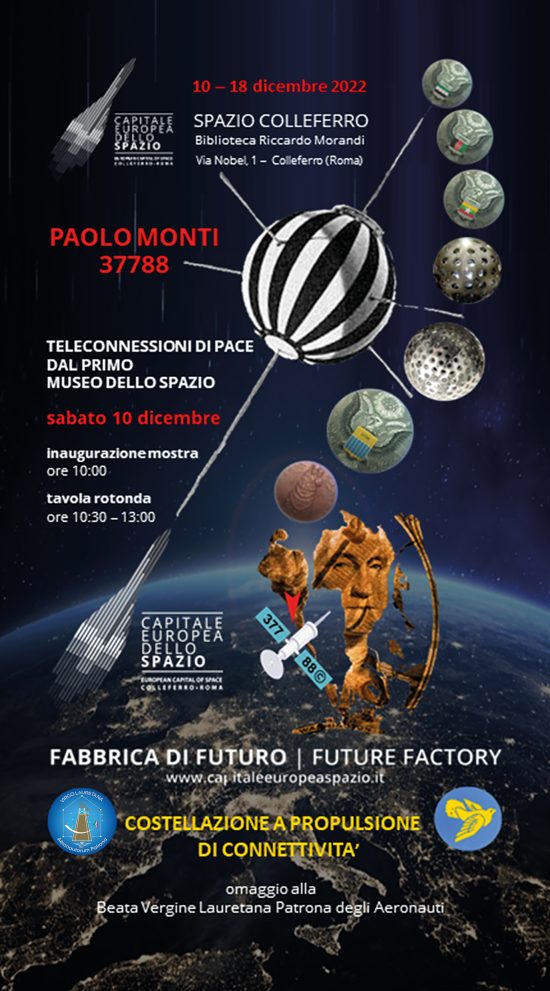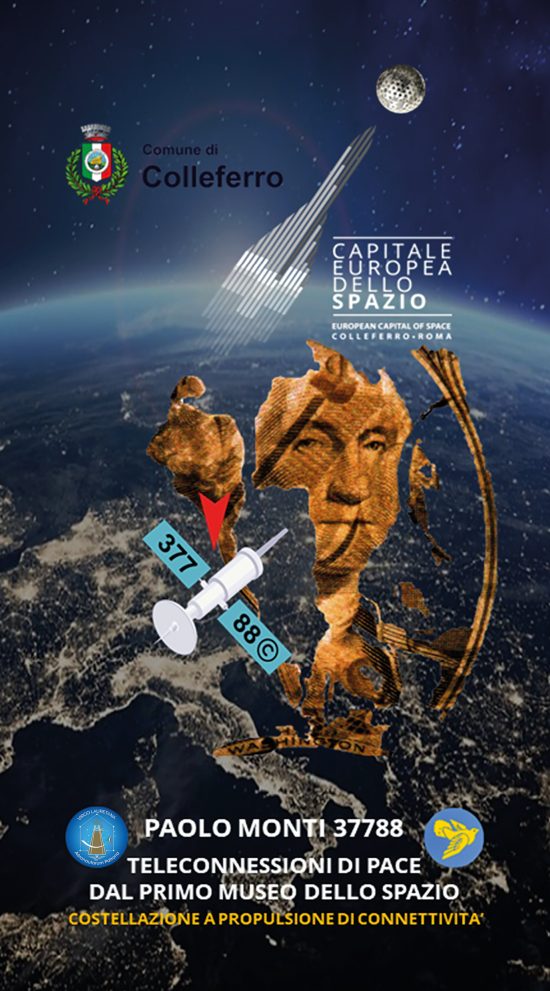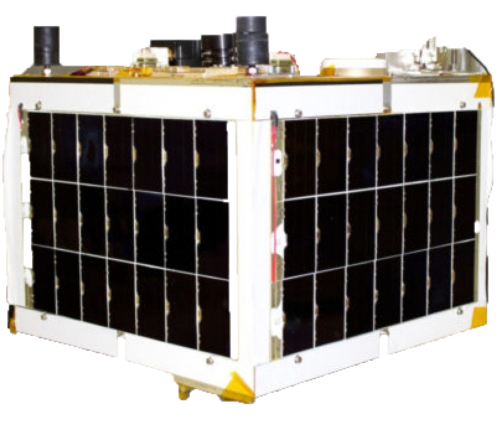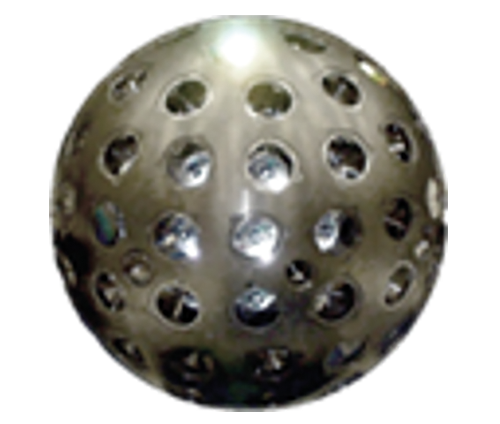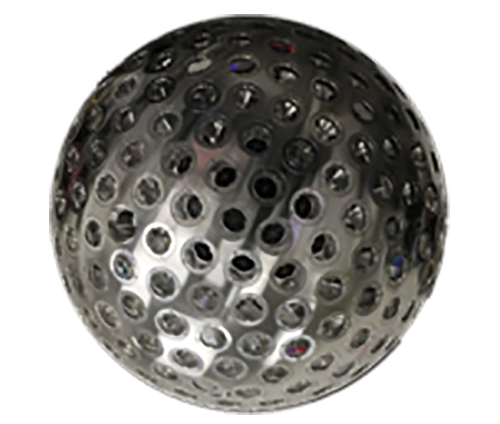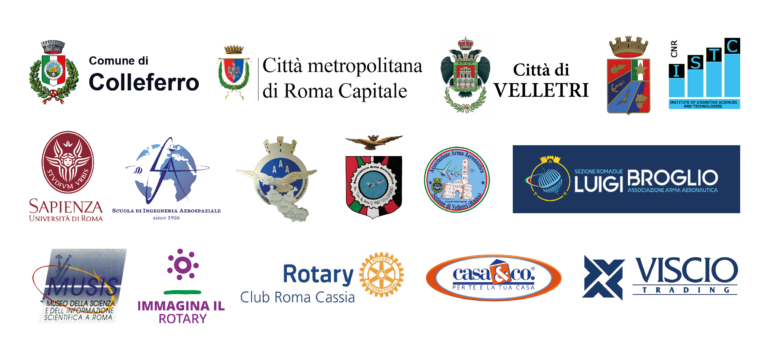TELECONNECTIONS OF PEACE FROM THE FIRST MUSEUM IN OUTERSPACE
CONSTELLATIONS BY CONNECTIVITY PROPULSION
Teleconnections of Peace. Propulsion Constellations of Connectivity from the first Museum of Space is the title of the work that Paolo Monti 37788 exhibited at the Colleferro Space during the celebrations for Colleferro European Capital of Space 2022.
The work originated from the meta-project InfraTazebAu s’pace. Information in Revolution. C.G.B. Epistemologically propelled satellite. Lift-off Shroud R.F.I.D. 21’37’’, started by Monti in 2005 following the tracks of Marco Polo to, subsequently, link it to “Space” in 2006 along with Paolo Nespoli’s signature at ESA-ESRIN, Frascati. The acronym C.B.G. stands for the Circle dedicated to the English epistemologist Gregory Bateson to whom the project is dedicated, while Shroud 21’37’’ is the title of the work in orbit, which consists of a washed-out dollar bill that conserves the image of George Washington embossed on the bank note. It is a true emblem of peace held on board of the micro-satellite EduSAT belonging to the Italian Space Agency, coordinated by the G.A.U.S.S. group, part of the Scuola di Ingegneria Aerospaziale (Engineering School of Space), SIA, University La Sapienza of Rome. It was founded by Gen. Ing. Luigi Broglio father of Italian Space, successfully launched in orbit together with the Russian-Ukrainian vector from the Kosmodrome in Yasny, 17th August 2011.
Paolo Monti chose the satellite EduSAT, ID: 37788 as his personal gallery and it is, in fact, the first Orbiting Museum in the world in memory of Lucio Fontana’s Spacialism and Yves Klein’s flight. Many have been the initiatives that have narrated their stories during these past eleven years, such as the exhibition Track Money Where’s George? within the European Researchers Night held in 2016 at the Italian Space Agency, supported by a conference in the Casini Room held by Paolo D’Angelo, with the participation, among others, Ing. Roberto Somma, well-known expert of Space.
Moving on from that experience, the work Teleconnections of Peace. Consellations by Connectivity Propulsion was created to twin the first Colleferro Space Museum to the Museum of Space 37788, an installation that uses a signal transmitted live by NORAD ID 37788 www.n2yo.com/?s=37788 in a twinning between Space-Earth-Art, also taken up in the work by an artist friend, Loris Alessandro Carlan, that was dedicated to Paolo Monti and which became the title of his personal exhibition shown contemporaneously at Colleferro Space.
The satellite EduSAT, first museum in orbit to urbanise Space, was teleconnected in Monti’s installation to two very special satellites: LARES 1 and LARES 2 (LAser RElativity Satellite), both launched using Vega, built by AVIO at Colleferro and created by Prof. Ignazio Ciufolini and designed at the S.I.A. by Prof. Antonio Paolozzi’s group together with the researcher Claudio Paris, responsible for the thermo-optical tests on the satellites LARES and EduSAT.
The work Teleconnections of Peace, on exhibition from 10-18 December, in honour of the Beata Vergine Lauretana, Patron of the Aeronauts, gave origin to a diffused space museum in various significant places on Earth, teleconnected to deep space in a Panoptic of observation on Creation, a holo-relational bridge of connectivity between Sky and Earth.
Coordination Arch. Laura Rossi
+39 338 8107315 – laurarossi@metatronzone.it
www.paolomonti37788.it – www.paolomonti.org
The Exhibition is accompanied by a Round Table, moderator Marco Regi, Engineer Advisor Ass. Arma Aeronautica (A.A.A.) to the Air force, section Rome 2, Luigi Broglio,
Greetings Address to:
Pier Luigi Sanna, Mayor of Colleferro and Metropolitan deputy mayor;
Orlando Pocci, Mayor of Velletri;
Francesco Guadagno, Councilor European Capital of Space, with the participation of:
Patrizia Audino, Psychologist, Writer, Lecturer of Philosophy & Human Science;
Luigi Campanella, Chemist, Distinguished Prof. University of Rome, La Sapienza, President MUSIS;
Nazzareno Cardinali, Gen. Isp. C. (r), President A.A.A. section Rome 2, L Broglio;
Giuseppe Cornacchia, Gen. B.A. (r), Vice President A.A.A. section Rome 2, Luigi Broglio;
Ivana Della Portella, Art Historian, Vice President Special Company PalaExpo Rome;
Denis Fadda, Professor, Président International de la Renaissance Française, Ancien Président de l’Acadèmie des Sciences d’Outre-Mer;
Rino Falcone, Physicist, Cognitive Scientist, Director of Research at ISTC-CNR;
Giuseppe Grande, Engineer, previously Director of Space Sector, protagonist for business transformations from B.P.D. at FIAT AVIO;
Loreto Lauri, Marshal Sub-Lieutenant, President A.A.A. Section Colleferro;
Antonio Paolozzi, Professor Aerospace Engineering School at La Sapienza Rome, Designer of LARES 1 & 2 (Laser Relativity Satellites);
Claudio Paris, Researcher Aerospace Engineering School, responsible for the thermal-optical tests of the satellites LARES and EduSAT;
Giorgio Priori, Engineer, Expert in finance and evaluation of financial risks;
Luisa Riccardi, Director of V Department “Technological Innovations“ to the General Secretariat of Defence/DNA;
Josè Juan Skof, Regional President A.A.A. Lazio Section and President A.A.A. Velletri Section;
Roberto Somma, Engineer, well-known expert in the space department in which he has been active for more than half a century. Among others, he has directed the development of observation of the Earth through radar techniques, subsequently extended to the observation of planets;
Lucia Viscio, Entrepreneur, Tertiary Consultant Women of Confcommercio, Rome, member of IWEC Foundation, National and International assignments for Rotary.
ANTICIPATING THE FUTURE
Giuseppe Grande
The birth of spatial activity at Colleferro
The B.P.D. came out of the Second World War completely destroyed.
In the first years after the war the company underwent a very effective industrial transformation from a military one, prohibited by the peace treaty, to a civilian one.
Yet, when the law consented to the production of ammunition once more, the corner-stone was laid for spatial activity entering with rocket propulsion: beginning with the production of 2inch rockets which then lead to engines for the Hawk missile.
The know-how which they gained allowed them to design, produce and launch sound rockets for research in the atmosphere and they began to participate in European Space Programmes with apogee engines to be integrated into satellites and then separating engines during the stages of ARIANE. This was followed by the designing, development and production of boosters for ARIANE, of an ever-increasing mass, from 7 tons for ARIANE 3 to 240 tons for the ARIANE 5.
The evolution which took place in systems engineering that followed permitted them to arrive at the production of a space launcher which was entirely Italian: the VEGA.
The CVA Communautè des Villes ARIANE
At the end of the year 2000 Italy, France and Germany incited by Arianspace, a society created for the promotion and management of services for the ARIANE boosters, came up with the idea of an Association that was made up of the largest possible numbers of companies involved with ARIANE and the towns where such companied were situated. The promotional activities carried out mainly by FIAT AVIO, MAN E CNES lead, in the space of one year, to the involvement of twenty-odd companies and their relative towns.
The aim of the CVA is to involve young people from European countries, also through exchange programmes and inter-cultural seminaries regarding spatial activities. The first seminaries took place in 2002 and 2003 with the participation of youths from Italy, France and Germany.
With consideration to the success which was obtained the number of companies and towns has grown over time with initiatives which, after 20 years, are more extensive and vivacious.
SPACE – EARTH – ART
Roberto Somma
The most significant stages in the history of the conquest of outer space by man stick in our minds through phrases pronounced by their protagonists and, very often, printed in history books for the benefit of those who were not present at the time. With reference to Space and Paolo Monti’s art, I would like to remember what was said on 12 April, 1961, by Yuri Gagarin, the first man ever to go into orbit around our planet: “From up here the earth is beautiful, with no frontiers nor borders.” An expression of love towards our planet rather than celebrative of man’s achievement, words which also transmitted an awareness of the value of the “privileged observation point” gained by man for the observation of the Earth, something which had gradually matured in our consciousness that the earth was a complex system: a true living organism in which the various spheres (biosphere, criosphere, idrosphere, atmosphere etc), and the various systems of our organism and the functions they carry out, interact to determine a complex state of well-being.
Yet, what is the connection between Paolo Monti’s work and Space? To converse with Paolo Monti isn’t the easiest thing in the world but, after conferring with him for several hours, I believe I have understood (… or, at least, I think I have)! The message entrusted to the work in orbit, goes by the difficult title to memorise of Infra-Tazebu s’pace 2011. Information in Revolution. C.G.B. Epistemologically propelled satellite. Lift-off Shroud R.F.I.D. 21’37’’.
A title, behind which, a de-faced dollar bill is concealed, one that has lost, through Paolo’s work, it’s connotation of “economic value” only to take on a re-identification as a symbol of connection between populations and cultures, acting as a “travel journal” along an iconic itinerary of encounters between civilizations: that of Marco Polo from Venice to China along the Silk Road, re-traced by a Motorcade in 2005. Their task was to record during the various stages along route, the signatures on the ex-dollar bill as witness of the encounters with the countries which they crossed and the peoples met along the way. The launch into Space and the placing of the work into orbit around the Earth is, therefore, a continuation of its journey, thanks to the hospitality of a vehicle which, by its very nature, does not take into account man-made boundaries on the planet’s surface and to which many tasks are assigned that contribute to the reciprocal knowledge of populations (think of telecommunications) and to the co division of many world-wide problems (consider the observation of the earth with the endeavour to protect the climate and environment).
Alongside this symbolic parallelism between the obit of Paolo Monti 37788 and space systems in general, I was struck during my first visit to his studio, by another parallelism which I could define only as “technological”, by the use of the artist of instruments of spectral bands not perceptible to the human eye, which permit him to enter into the nature of that which is observed, to follow its evolution in time, ultimately capable of “seeing” the “invisible”. Therefore, I was immediately struck by the similarity by which, even if for different aims, satellites of observation, that use instruments which operate in spectral bands where aspects of interests for the diagnosis of the state of the well-being of our planet are manifested and become visible.
However, here ends the parallelism, from the moment that, in Paolo’s work, the elaboration of images becomes art, through their transformation not merely for graphic purposes but as instruments of transmission of a thought, a concept, often expressed cryptically, as in the case of the dollar bill in orbit, where the observer is invited to interpret the title of the work in order to be able to comprehend the artist. In its roaming around the Earth, EduSAT, which has become an orbiting gallery/museum of the “dollar shroud”, is no longer possible to visit directly but, nevertheless, it communicates its position, and that of George Washington exhibited within, through a radio signal emitted by the satellite, which is received on Earth and has as a receiver another work of art by the same artist, Paolo Monti, inspired by the fact that Colleferro was nominated European Capital of Space. Symbolically, this teleconnection of peace, by its very nature, brings into action the twinning of two museums: that in orbit with EduSAT which became the first “Museum of Space” and the “Colleferro Space Museum”, its “blood brother” on earth.
EDUSAT, THE LARES SATELLITES AND COLLEFERRO: A TWINNING MADE POSSIBLE
Antonio Paolozzi
The Scuola di Ingegneria Aerospaziale (Engineering School of Space), SIA, of the University Sapienza of Rome, instituted in 1963 by Prof. Gen. Luigi Broglio, father of Italian Space, with the project S. Marco allowed Italy to become the third nation in the world (after the Soviet Union and the United States) by launching the satellite S. Marco 1, in 1964. Many other launches took place following that extraordinary event. Since the year 2000 the School, lead by Deans Filippo Graziani and Paolo Teofilatto, has continued its pioneering activities with the programme of university micro-satellites through which it was the first university in the world to launch them bi-annually. Apart from the university courses, the SIA has also turned its attention towards Secondary Schools with their programme “Space Science in School” which truly culminated on 17th August, 2011, with the launching of the microsatellite EduSAT which weighed 10kgs, created and built in collaboration with the aerospace company GAUSS and to which students and professors of the SIA and Secondary Schools participated. The Engineering School of Space, ever aware of new challenges, welcomed the proposal of artist Paolo Monti to insert one of his works inside the satellite; in so doing rendering the satellite, not only a scientific and didactic instrument but, also, a means of promoting art among the young, and not only. The following year the satellite LARES was launched with VEGA, the launcher which was created and built principally in Colleferro. This year, on 13th July, 2012 also the LARES 2 was sent into orbit with exceptional precision by VEGA C, the new version of VEGA. These two satellites, part of an experiment by Prof. Ignazio Ciufolini to verify the theory of general relativity, were designed by the Aerospace Engineering School by my group and will be treated in a Round Table Event together with my colleague, Claudio Paris, responsible for the thermal-optical tests of the satellites LARES and EduSAT. During the exhibition, a brief experiment will be carried out to describe the properties of this satellite, also in relationship to the work “Telecommunications of Peace”, ideated by Monti to twin them with Colleferro European Capital of Space 2022.
SPACE – ART – ECONOMY
Giorgio Priori
We are finally living in a new space race. This century will be, with a bit of luck, similar to that which saw the birth of the great ocean explorers in order to expand the confines of the known world.
On the contrary of what actually took place, in an era that was still analogical, for the race to conquer the moon in the 60’s, today private interests plus economical interests have become, just like at the time of Magellano, the true mechanism that drives these rockets outside the earth gravity well.
Paolo Monti’s work 37788 that continues to orbit just outside the atmospheric boundary inserts itself, in a most surprising way, like a digital-analog interface in this paradigm of the new Space-Economy.
ART IN ORBIT
Ivana Della Portella
Since the 80’s, Paolo Monti 37788 has operated in the sphere of visual art creating meta-environmental works aimed at diminishing the perceptive threshold between the visible and non-visible. His research, placed at the limit between Art and Science, is carried out in works where the observer, through active involvement, becomes the participating subject capable of modifying the outcome.
Exactly eleven years have gone by since that 28th November, 2011, when Paolo asked me to lead a day of studies entitled: Burning Takeoffs. Art Infra-seen from Above in the Sala Odeion, in the Museum of Classical Art, University of La Sapienza, Rome, dedicated to his work Infra-TazebAu s’pace – Information in Revolution. C.G.B. Epistemologically propelled satellite. Lift-off Shroud 21’37’’ R.F.I.D.
This work, created for the microsatellite EduSAT 37788, is made up of a one dollar bank note which had been defaced, washed out and signed by all the participants of the mission that successfully took it into orbit on 17th August, 2011. Operating as an almost ready-made museum, Monti converted the EduSAT satellite into his orbiting gallery and the first ever Space Museum in the world in fact!
In its orbiting around the Earth at an altitude of 700 km and a speed of 28.000 km per hour, the orbiting museum communicates its position to us, and that of the dollar bill Shroud 21’37’’ on board, through a radio signal sent out by the satellite and transmitted live from NORAD (North American Aerospace Defence Command) ID: 37788, which has now become an integral part of its name.
A link-up between Earth and Space is the basis of the work Teleconnections of Peace. Propulsion Constellations of Connectivity, a site-specific project created for Colleferro European Capital of Space 2022, with the aim to twin the first Museum of Space to the Colleferro Space Museum, a propulsion installation that visualises the position and route in Space through a signal transmitted to Earth by NORAD, in an analog-digital synesthesia
.
Rassegna Stampa
- Colleferro, musica e mostre nel fine settimana Eventi a Frosinone (frosinonetoday.it)
- Colleferro-la-mostra-teleconnessioni-di-pace-dal-primo-museo-dello-spazio
- Colleferro. “Natale 2022”. Gli eventi del weekend: mostra (Biblioteca comunale), concerti (Auditorium e Teatro Vittorio Veneto), azione teatrale itinerante (Rifugi antiaerei) – Cronache Cittadine
- Colleferro, musica e mostre nel fine settimana – Roma e dintorni notizie
Comune di Colleferro > vai alla pagina
TELECONNESSIONI DI PACE – PAOLO MONTI 37788
Ieri mattina, nell’aula di alta formazione della Biblioteca Comunale R. Morandi, è stata inaugurata la mostra ospitante l’opera di Paolo Monti 37788 “Teleconnessioni di pace. Costellazioni a propulsione di connettività dal primo Museo dello Spazio”.
L’opera è stata ideata per gemellare il Museo Spazio Colleferro al Museo dello Spazio 37788, un’installazione che impiega il segnale trasmesso in tempo reale dal satellite EDUSAT, primo museo in orbita, teleconnesso a due satelliti lanciati con il VEGA realizzato da AVIO a Colleferro.
La mostra è stata affiancata da una tavola rotonda, moderata dall’ing. Marco Regi dell’Associazione Arma Aeronautica, a cui hanno partecipato il Sindaco di Velletri Orlando Pocci, il Sindaco di Colleferro Pierluigi Sanna, l’Assessore Francesco Guadagno, il Consigliere Umberto Zeppa, rappresentanti dell’Arma Aeronautica, docenti universitari e personalità di spicco come l’Ing. Giuseppe Grande, il Prof. Denis Fadda e l’Ing. Roberto Somma.
L’opera rimarrà in mostra dal 10 al 18 dicembre in Biblioteca.

